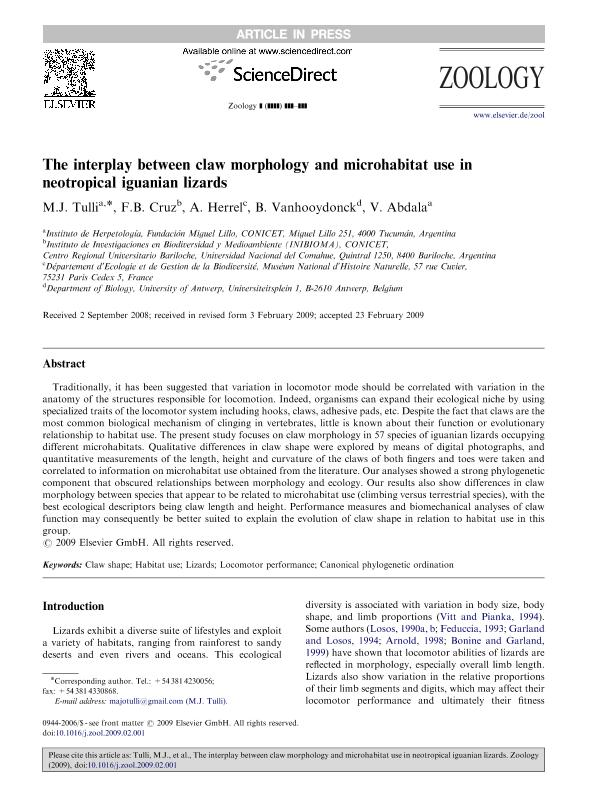Artículo
The interplay between claw morphology and microhabitat use in neotropical iguanian lizards
Tulli, María José ; Cruz, Felix Benjamin
; Cruz, Felix Benjamin ; Herrel, Anthony; Vanhooydonck, Bieke; Abdala, Virginia Sara Luz
; Herrel, Anthony; Vanhooydonck, Bieke; Abdala, Virginia Sara Luz
 ; Cruz, Felix Benjamin
; Cruz, Felix Benjamin ; Herrel, Anthony; Vanhooydonck, Bieke; Abdala, Virginia Sara Luz
; Herrel, Anthony; Vanhooydonck, Bieke; Abdala, Virginia Sara Luz
Fecha de publicación:
09/2009
Editorial:
Elsevier Gmbh
Revista:
Zoology
ISSN:
0944-2006
Idioma:
Inglés
Tipo de recurso:
Artículo publicado
Clasificación temática:
Resumen
Traditionally, it has been suggested that variation in locomotor mode should be correlated with variation in the anatomy of the structures responsible for locomotion. Indeed, organisms can expand their ecological niche by using specialized traits of the locomotor system including claws, adhesive pads, etc. Despite the fact that claws are the most common biological mechanism of clinging in vertebrates, little is known about their function or evolutionary relationship to habitat use. The present study focuses on claw morphology across lizards occupying different microhabitats in 57 species of iguanian lizards. Qualitative differences in claw shape were explored by means of digital photographs and quantitative measurements of the length, height and curvature of the claws of both fingers and toes were taken and correlated to information on microhabitat use obtained from the literature. Our analyses showed a strong phylogenetic component, obscuring relationships between morphology and ecology with animals occupying similar habitats often being closely related. Our results also show differences in claw morphology between species that appear to be related to microhabitat use (climbing versus terrestrial species), with the best ecological descriptors being claw length and height. Performance measures and biomechanical analyses of claw function may consequently be better suited to explain the evolution of claw shape in relation to habitat use in this group.
Archivos asociados
Licencia
Identificadores
Colecciones
Articulos(CCT - NOA SUR)
Articulos de CTRO.CIENTIFICO TECNOL.CONICET - NOA SUR
Articulos de CTRO.CIENTIFICO TECNOL.CONICET - NOA SUR
Citación
Tulli, María José; Cruz, Felix Benjamin; Herrel, Anthony; Vanhooydonck, Bieke; Abdala, Virginia Sara Luz; The interplay between claw morphology and microhabitat use in neotropical iguanian lizards; Elsevier Gmbh; Zoology; 112; 5; 9-2009; 379-392
Compartir
Altmétricas



